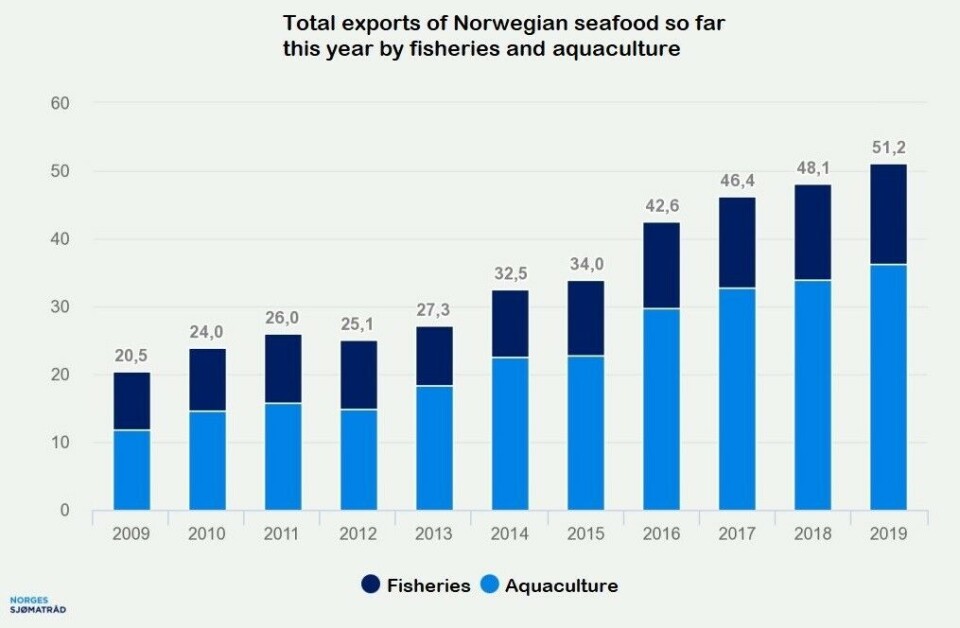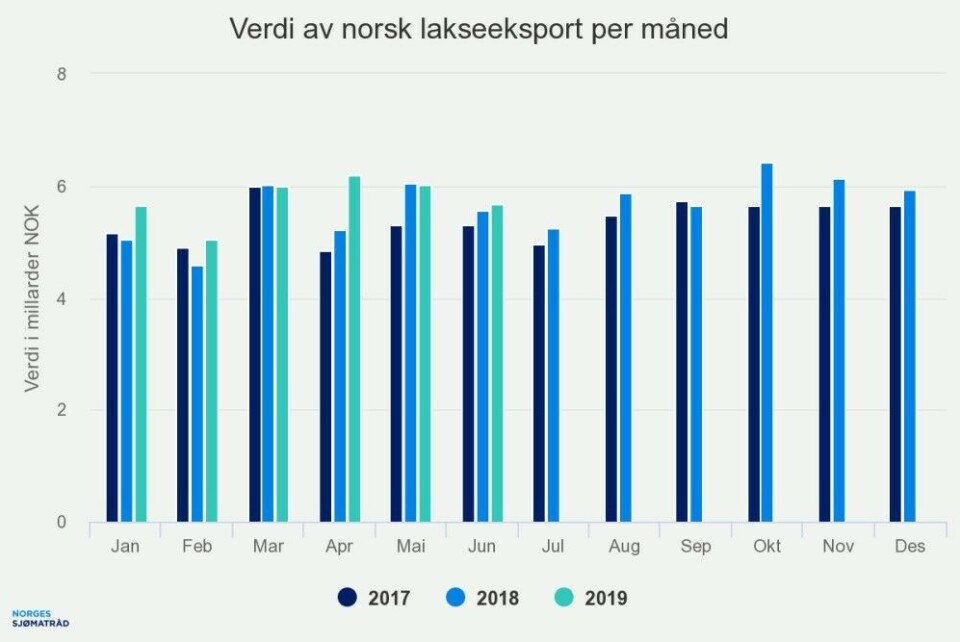
Salmon the key as Norway breaks export value record
Norway exported seafood worth a record-breaking NOK 51.2 billion (£4.8bn) in the first half of 2019, with the increase largely due to salmon farming, the Norwegian Seafood Council has reported.
“Norway has never exported seafood for such great values in six months. Norwegian salmon account for about two-thirds of the growth in value this half-year, and we also see a nice increase in value, for example in shellfish exports,” said the Seafood Council.
The export volume of 1.3 million tonnes declined compared to the same period last year, mainly due to reduced exports of blue whiting and reduced fishing quotas.
Good demand for Norwegian seafood is steady, and better access to individual markets is being seen, said the Council. In addition, a weak Norwegian krone has given higher prices for exports of Norwegian seafood to euro and dollar markets.

Growth in demand
“The sum of this is a record-high half year for Norwegian seafood exports,” said Tom-Jørgen Gangsø, the Council’s director of market insight and market access.
Norway exported 163,000 tonnes of seafood at a value of NOK 7.9bn in June. That is a volume decline of 19% compared to June 2018, although value remained the same.
Norway exported 506,000 tonnes of salmon for NOK 34.6bn in the first half. This is an increase of 5% by volume, while the value increased by NOK 2.1 billion or 6% compared with the first half of last year. Poland, France and Denmark were the largest markets.
“We have had stronger production growth of salmon in the first half of the year than was expected at the beginning of the year. At the same time, we have experienced a growth in demand, especially from the EU and Asia,” said Gangsø.
“The growth in demand, together with a weak krone, explains why we have also experienced price inflation while volumes have increased.”

China takes more
The Council said it had seen growth in both value and volume in exports of fresh salmon to China. Overall, 12,130 tonnes of fresh salmon from Norway were exported to China after the first six months of the year - more than was exported throughout 2018, when China took 12,000 tonnes.
“We are now seeing considerably more Norwegian salmon in China,” said Victoria Braathen, the Seafood Council’s mission chief in China.
“The increased exports are mainly due to improved market access in the form of more efficient trading, and that new manufacturers have gained access to the market.
“On average, about 200 tonnes of Norwegian salmon are imported into China every week than the same period in 2018. If growth continues, we can imagine that Norway will export more than 20,000 tonnes of salmon to China during 2019. Norway continues to strengthen its position and take an increasing share of the growth in demand in the market.”
In June, Norway exported 82,300 tonnes of salmon worth NOK 5.7bn. This is a decrease in volume of 3%, while the value increased by 2% or NOK 133 million compared to June last year. The average price for fresh whole salmon increased from NOK 61.77 to NOK 64.20 per kilogram.
Trout exports rise
Norway exported 24,700 tonnes of trout for NOK 1.7bn in the first half of 2019. The volume increased by 19%, while the value increased by NOK 276 million or 20% compared with the first half of last year. The US, Belarus and Thailand have been the largest markets this year.
“In addition to the volume growth, there has also been a shift towards fillet exports of trout in the first half of 2019,” said Gangsø.
“We see a special growth in the US market, where Norwegian trout is constantly gaining ground, as a result of increased availability in both the retail trade and in the restaurant market.
“The volume increase has led to somewhat lower prices for both fresh and frozen whole fish, but at the same time we see that fillet prices have increased. Some of this can probably be explained by the fact that the Norwegian krone is particularly weak against the dollar.”




















































